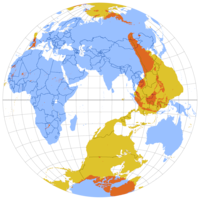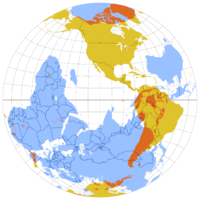This article has multiple issues. Please help improve it or discuss these issues on the talk page. (Learn how and when to remove these messages)
|
In geography, the antipode (/ˈæntɪˌpoʊd, ænˈtɪpədi/) of any spot on Earth is the point on Earth's surface diametrically opposite to it. A pair of points antipodal (/ænˈtɪpədəl/) to each other are situated such that a straight line connecting the two would pass through Earth's center. Antipodal points are as far away from each other as possible.[note 1] The North and South Poles are antipodes of each other.
In the Northern Hemisphere, "the Antipodes" may refer to Australia and New Zealand, and Antipodeans to their inhabitants.[2] Geographically, the antipodes of the British Isles are in the Pacific Ocean, south of New Zealand. This gave rise to the name of the Antipodes Islands of New Zealand, which are close to the antipode of London. With the exception of a part of the Perth metropolitan area near Baldivis and Rockingham that is antipodal to Bermuda, the antipodes of Australia are in the North Atlantic Ocean, while parts of Spain, Portugal, France and Morocco are antipodal to New Zealand.
Approximately 15% of land territory is antipodal to other land, representing approximately 4.4% of Earth's surface.[3] Another source estimates that about 3% of Earth's surface is antipodal land.[4] The largest antipodal land masses are the Malay Archipelago, antipodal to the Amazon basin and adjoining Andean ranges; east China and Mongolia, and small sections of southeast Russia, antipodal to Argentina and Chile; and Greenland and the Canadian Arctic Archipelago, antipodal to East Antarctica. There is a general paucity of antipodal land because the Southern Hemisphere has comparatively less land than the Northern Hemisphere and, of that, the antipodes of Australia are in the North Atlantic Ocean, while the antipodes of southern Africa are in the North Pacific Ocean.
- ^ "antipodes". Dictionary.com. Retrieved 2 December 2017.
- ^ "Antipodes". Compact Oxford English Dictionary. 2008. Archived from the original on 1 October 2005. Retrieved 21 February 2010.
- ^ Sawe, Benjamin Elisha (25 April 2017). "What Is An Antipode In Geography?". World Atlas. Retrieved 16 March 2019.
- ^ Cite error: The named reference
Spilhaus1991was invoked but never defined (see the help page).
Cite error: There are <ref group=note> tags on this page, but the references will not show without a {{reflist|group=note}} template (see the help page).

